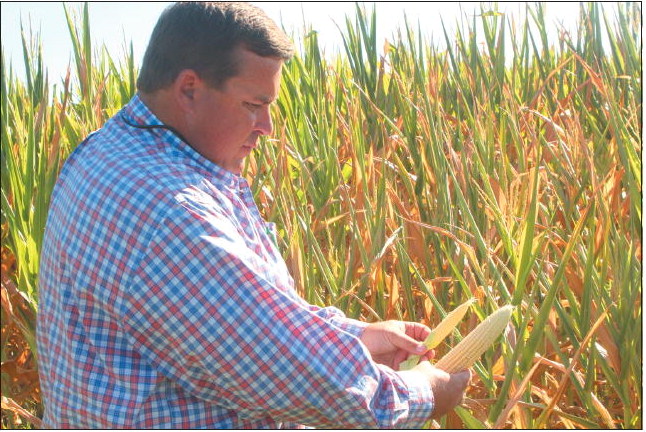continued from page For ….


continued from page
For Hopkins, the battle to save his corn never ends, as the corners of his field which are not reached by the pivot are already dry and dead. “This corn is already trying to make ears, so we cannot afford to sacrifice this crop,” he emphasized. “I cannot even use irrigation on my cotton fields because I cannot take water off of my corn.”
Because of the lack of moisture in these cotton fields, the seeds are struggling to make any progress. In fact, those sewn in fields without any sort of irrigation can easily be dug up from the ground.
Yet, it is not just heat and the lack of moisture harming the crops; because of the combination of these conditions with the steady wind in the area, Hopkins is unable to use the normal herbicides which he usually utilizes to protect his plants. “The wind has also complicated things. We’ve had high 90s temperatures in June with wind so we can’t spray crops with herbicide because of surrounding crops that are sensitive. That wind is also nonstop and just drying us out,” he added.
“This [hot weather and lack of rain] is something you do not think of unless you are in production agriculture and depend on it daily,” Hopkins summarized.
L ocallivestockowners are also struggling to provide for their herds during this arid weather. “It’s miserably dry and hot,” L.G. Herndon, Jr. Farms owner Bo Herndon remarked. “It’s affecting everything. We’re pumping ponds dry and have been running the well nonstop for six weeks now to make sure everything has water.”
He continued, “Once cows eat the grass down in a pasture and there’s no rain, there is no grass. We are having to continuously move cattle to different pastures, which is a long and tedious process.”
Ohoopee Angus Farms Owner Tara Wilkes also spoke on the struggles which the heat is causing for her business. “Livestock operations are suffering from the drought also. The ultimate result of drought is a reduction in forage production. We depend on being able to graze our animals during this time of year on open pasture and we spend a lot of time in the summer growing and baling hay to feed during winter months. Drought not only depletes our summer grazing but also impacts us for months to come. Not only do we produce less hay, we have no choice but to begin feeding it now, reducing our feed inventory before winter even arrives.”
Wilkes added, “The quality of the forage is also adversely affected by drought stress, tending towards lower protein levels and higher nitrate levels. Any time forage is reduced by quality and quantity, problems can be expected. Cattle will experience reduced pregnancy rates, loss of body condition, and likely, a reduction in milk production which in turn, can lower calf weaning weights.”
According to Toombs County Extension Coordinator Jason Edenfield, the current dry period is not as historically dry as the drought of 2022, but is much drier than the past years of 2021 and 2023. “We are not the driest that we have ever been, but we definitely need rain,” he commented. “The heat and lack of moisture is definitely taking a toll on the area.”
Edenfield shared that the last significant rainfall which the area has received was on May 25, when a little less than an inch of rain was recorded. “We had a lot of rain early – 23 total inches have fallen in the county this year – but we have only had 50 rainy days,” he clarified. “This early rain pushed the planting period later, which has been a problem because of the heat’s effect on the young crops.”
He continued, “Luckily, in Toombs County, many of our fields are irrigated because of the amount of vegetables we grow; so, even if we are not receiving rain, farmers can pump rain onto these fields. Yet, there are also several nonirrigated fields in the county, a lot of which are being destroyed through this heat. And for the cattle guys, this dry weather is brutal.”
The exact difference in crop yield cannot yet be calculated Edenfield said, but he is hopeful rain will come soon. “We are showing rain in the forecast this week; it would be a blessing,” he shared.








